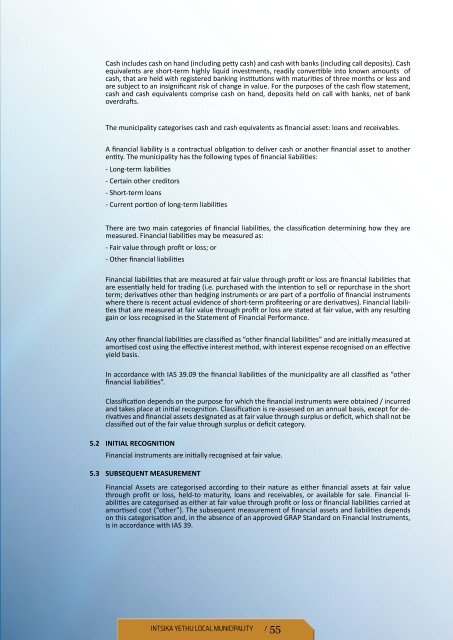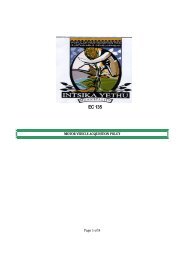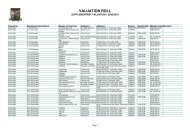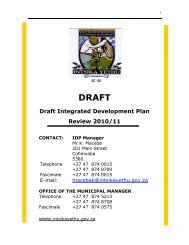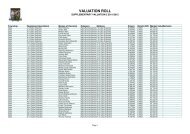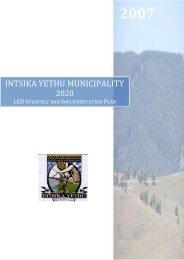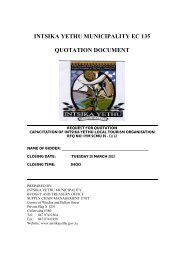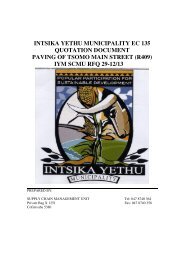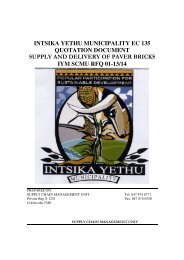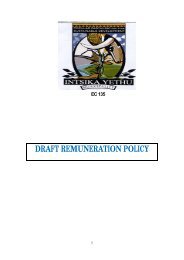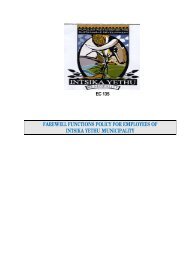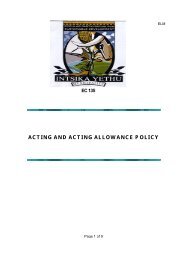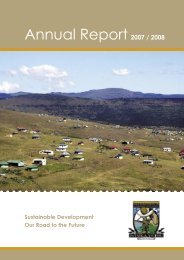annual report 2010 - 2011 - Intsika Yethu Municipality
annual report 2010 - 2011 - Intsika Yethu Municipality
annual report 2010 - 2011 - Intsika Yethu Municipality
You also want an ePaper? Increase the reach of your titles
YUMPU automatically turns print PDFs into web optimized ePapers that Google loves.
Cash includes cash on hand (including petty cash) and cash with banks (including call deposits). Cash<br />
equivalents are short-term highly liquid investments, readily convertible into known amounts of<br />
cash, that are held with registered banking institutions with maturities of three months or less and<br />
are subject to an insignificant risk of change in value. For the purposes of the cash flow statement,<br />
cash and cash equivalents comprise cash on hand, deposits held on call with banks, net of bank<br />
overdrafts.<br />
The municipality categorises cash and cash equivalents as financial asset: loans and receivables.<br />
A financial liability is a contractual obligation to deliver cash or another financial asset to another<br />
entity. The municipality has the following types of financial liabilities:<br />
- Long-term liabilities<br />
- Certain other creditors<br />
- Short-term loans<br />
- Current portion of long-term liabilities<br />
There are two main categories of financial liabilities, the classification determining how they are<br />
measured. Financial liabilities may be measured as:<br />
- Fair value through profit or loss; or<br />
- Other financial liabilities<br />
Financial liabilities that are measured at fair value through profit or loss are financial liabilities that<br />
are essentially held for trading (i.e. purchased with the intention to sell or repurchase in the short<br />
term; derivatives other than hedging instruments or are part of a portfolio of financial instruments<br />
where there is recent actual evidence of short-term profiteering or are derivatives). Financial liabilities<br />
that are measured at fair value through profit or loss are stated at fair value, with any resulting<br />
gain or loss recognised in the Statement of Financial Performance.<br />
Any other financial liabilities are classified as “other financial liabilities” and are initially measured at<br />
amortised cost using the effective interest method, with interest expense recognised on an effective<br />
yield basis.<br />
In accordance with IAS 39.09 the financial liabilities of the municipality are all classified as “other<br />
financial liabilities”.<br />
Classification depends on the purpose for which the financial instruments were obtained / incurred<br />
and takes place at initial recognition. Classification is re-assessed on an <strong>annual</strong> basis, except for derivatives<br />
and financial assets designated as at fair value through surplus or deficit, which shall not be<br />
classified out of the fair value through surplus or deficit category.<br />
5.2 INITIAL RECOGNITION<br />
Financial instruments are initially recognised at fair value.<br />
5.3 SUBSEQUENT MEASUREMENT<br />
Financial Assets are categorised according to their nature as either financial assets at fair value<br />
through profit or loss, held-to maturity, loans and receivables, or available for sale. Financial liabilities<br />
are categorised as either at fair value through profit or loss or financial liabilities carried at<br />
amortised cost (“other”). The subsequent measurement of financial assets and liabilities depends<br />
on this categorisation and, in the absence of an approved GRAP Standard on Financial Instruments,<br />
is in accordance with IAS 39.<br />
INTSIKA YETHU LOCAL MUNICIPALITY / 55


